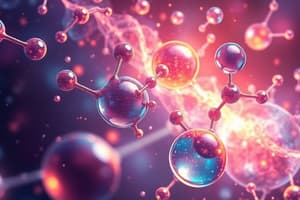Podcast
Questions and Answers
Chemistry is defined as the study of energy transformations, specifically focusing on heat and work.
Chemistry is defined as the study of energy transformations, specifically focusing on heat and work.
False (B)
Molecules are considered the fundamental units of matter in any state because they possess the capability of independent existence.
Molecules are considered the fundamental units of matter in any state because they possess the capability of independent existence.
True (A)
A heterogeneous substance is made up of molecules containing the homogenous kind of atoms.
A heterogeneous substance is made up of molecules containing the homogenous kind of atoms.
False (B)
Elements and compounds are both classified as impure substances due to their complex molecular structures.
Elements and compounds are both classified as impure substances due to their complex molecular structures.
A molecule must always consist of different types of atoms bonded together.
A molecule must always consist of different types of atoms bonded together.
An element is a complex form of matter that can be decomposed into simpler substances through chemical reactions.
An element is a complex form of matter that can be decomposed into simpler substances through chemical reactions.
Hydrogen and Helium comprise approximately 99% of all known matter in the universe.
Hydrogen and Helium comprise approximately 99% of all known matter in the universe.
Atoms are the largest particles of an element that retain the element's chemical properties and can participate in a chemical reaction.
Atoms are the largest particles of an element that retain the element's chemical properties and can participate in a chemical reaction.
The term 'atomicity' refers to the number of molecules in a single element.
The term 'atomicity' refers to the number of molecules in a single element.
Noble gases, certain metals, and carbon exist as diatomic molecules, meaning they naturally form molecules with two atoms.
Noble gases, certain metals, and carbon exist as diatomic molecules, meaning they naturally form molecules with two atoms.
Flashcards
What is Chemistry?
What is Chemistry?
Branch of science studying matter, its nature, structure, and changes under different conditions.
What is a molecule?
What is a molecule?
The smallest particle of matter capable of independent existence.
What is a pure substance?
What is a pure substance?
Substance made of molecules with the same kind of atoms and uniform composition.
What is an element?
What is an element?
Signup and view all the flashcards
What is an atom?
What is an atom?
Signup and view all the flashcards
What is atomicity?
What is atomicity?
Signup and view all the flashcards
What are monoatomic molecules?
What are monoatomic molecules?
Signup and view all the flashcards
What are pure substances?
What are pure substances?
Signup and view all the flashcards
Study Notes
The Language of Chemistry
- Chemistry is a branch of science studying matter, its nature, structure, and changes under different conditions.
- Many theories helped discover the essence of matter.
- Molecules are considered the basic units of matter.
- A molecule is the smallest particle of matter with independent existence.
Pure Substances
- A pure substance comprises molecules with the same kind of atoms.
- Pure substances have a definite composition and properties like boiling point, melting point, and density.
- Pure substances are homogeneous, meaning their composition is uniform.
- Carbon dioxide gas is a pure substance with molecules made of two oxygen atoms and one carbon atom.
- Elements and compounds are pure substances.
Molecules and Elements
- A molecule may contain similar or dissimilar atoms.
- An element is a pure substance with molecules made of the same kind of atoms.
- An element is a simple substance that cannot be broken down into simpler substances.
- There are currently 118 known elements.
- Hydrogen and helium make up the majority of the universe's mass, while all other elements make up only 1%.
Atoms
- All elements consist of atoms, the smallest particles representing the element's properties.
- An atom is the smallest particle of an element that may or may not exist independently, but can participate in a chemical reaction.
- A set of identical atoms forms the molecule of the element.
Atomicity
- Atomicity describes the number of atoms in a molecule of an element.
- Elements with only one atom in their molecules are monoatomic, like noble gases (Helium, Neon, Argon, Krypton, Xenon, Radon), metals, and carbon.
Studying That Suits You
Use AI to generate personalized quizzes and flashcards to suit your learning preferences.




